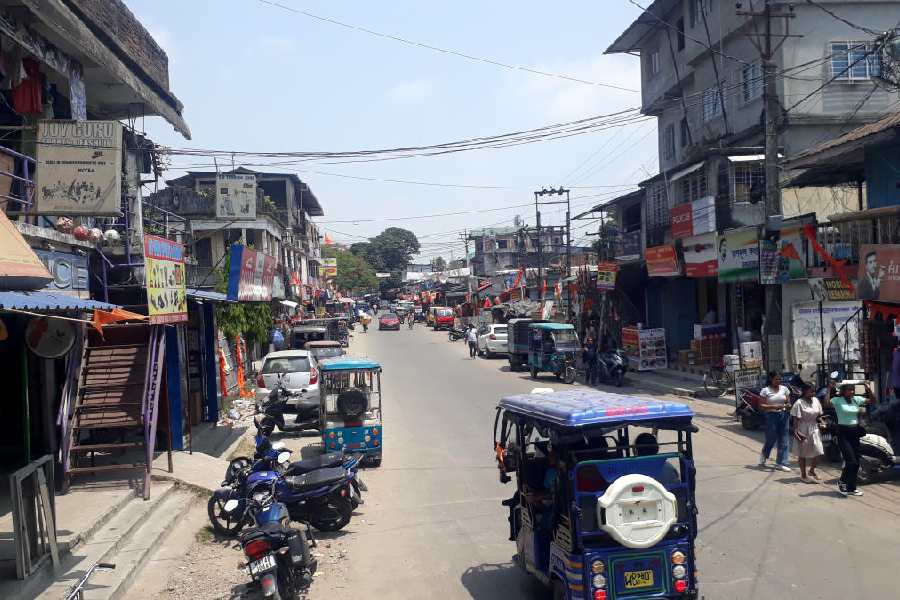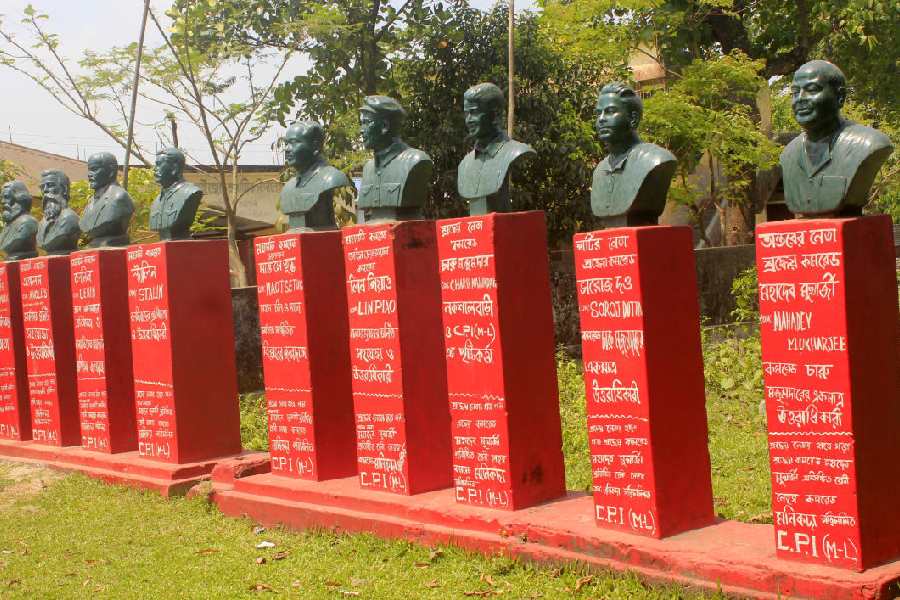The busts of Karl Marx, Friedrich Engels, Vladimir Lenin, Joseph Stalin, Mao Zedong, Lin Piao and Charu Majumdar find a pride of place in this small hamlet, barely 25km from here, nestled on the India-Nepal border, reminding the influence they once had on people living in the area.
Their revolutionary teachings, however, seem to be fading in Naxalbari, which witnessed an armed peasants’ uprising 57 years ago as farmers demanded their legitimate rights on land.
The philosophy of “Langol jar, jomi tar (Land belongs to the tiller)” — the immortal slogan of Naxalbari that sent shivers down the spines of the local zamindars — has been replaced by the doctrine of “Felo kori, makho tel (Pay a price and take away the goods)” as the peasant community is busy finding buyers to sell off their plots.
“The movement here had a huge impact on the politics of our country... It is believed
that this movement had prompted the Left Front government of Bengal to launch Operation Barga through which land was distributed among farmers,” said Avijit Majumdar, the son of late Charu Majumdar, who had spearheaded the Naxalbari movement along with his comrades like Kanu Sanyal and Jangal Santhal.
“Today, the situation is just the reverse. Farmers are selling off their agricultural plots to anyone who is willing to offer a good price,” Avijit, the state secretary of CPIM-L (Liberation), added.

Naxal leader Kanu Sanyal’s house in Sebdejjalote of Naxalbari block. Picture by Passang Yolmo
His father — who was born in a landlord family — had started and was the general secretary of the Communist Party of India (Marxist-Leninist) (CPIM-L). Born in Siliguri, he had joined the Communist Party of India during the Indian nationalist movement and then played a key role in uniting peasants against the landlords.
As the story goes, in March 1967, a sharecropper was beaten up by a “zamindar”, which infuriated the farmers — already fed up with the exploitative tendencies of the landlords — and they formed peasant committees to take control of farmland.
Armed clashes broke out which culminated in the killing of a policeman in May 1967. Within a few days, the enraged policemen fired at a march organised by the peasants, in which nine women and a child were killed.
The movement then spread to other parts of Siliguri sub-division. Attacks on the “zamindars” continued, prompting the state to deploy paramilitary forces in July, following which some leaders like Tilka Majhi were killed. Several others like Jungle Santhal were arrested and scores of others went underground. Later, Charu Majumder was also arrested.
Dipu Haldar, a few among those in Naxalbari to have retained the revolutionary traits, still holds the CPI-ML flag, but the 51-year-old woman pleaded helplessness with the turn of events in this seat of protest.
“It is surprising that even descendants of our prominent leaders, who had led the movement to get land for the farmers, are selling their ancestral land. We are trying to stop them but they are handing over the land to land sharks, who are selling the plots to people coming from the Northeast, mostly Manipur, and settling here. Such sale is also leaving an impact on agriculture and land-owing pattern is fast changing in the area,” said Haldar.
She had been a close associate of Kanu Sanyal and is the state secretary of one of the splinter groups of CPI-ML that was headed by Sanyal.
Haldar mentioned how a relative of Jungle Santhal, a forerunner of the movement, sold land at a premium.

The local market in Naxalbari. Picture by Passang Yolmo
“During the Left rule, the state had provided three bighas of land to Jungle Santhal. Around five-six years back, this man sold it. We tried to stop him but he didn’t relent,” she added.
Residents of the block said that over the past six-seven years, prices of land have considerably increased in Naxalbari, strategically located along the Asian Highway, which connects Panitanki, along the India-Nepal border, and Fulbari, along the Indo-Bangladesh border.
“One bigha of agricultural land is being sold at ₹ 25 lakh a bigha... However, plots near the Asian Highway are three to four times dearer,” said a local trader.
Gautam Ghosh, a senior CPM leader who is based in Naxalbari, said the demand for land parcels has risen due to several reasons, including the influx from the Northeast.
On the other hand, a section of people are buying land, especially those that are close to the Asian Highway, he said.
“While some are setting up hotels and resorts, others are investing in land in anticipation of future capital gains. As they are enticing local people with good deals, people are selling their agricultural land, despite realising they are becoming landless. We don’t know how to stop this trend,” said Ghosh.
Ramesh Singha, who lives in Bengaijote — a village in Naxalbari block — near the busts of the Left leaders, however, is a study in contrast in an area where people are desperate to sell off their land. Dhaneswari Devi, his grandmother, had died in police firing in 1967.
According to Ramesh, the other important change that has taken place in the area is the people’s attitude towards elections.
“This region has a history of boycotting elections... My father Paban Singha never voted during his lifetime. We, however, vote every time with an expectation that parliamentary democracy may bring in positive developments for us,” Ramesh told this newspaper.
The political parties, however, have not delivered on their expectations.
“There is no scope for employment for the youths here... There has been a steady migration from Naxalbari,” said Ramesh, adding that lack of employment opportunities and falling returns from agriculture are the reasons behind the trend of large-scale sale of agricultural plots.
The Naxalbari block has a population of around two lakh, of whom around 26 per cent are Scheduled Castes while another 20 per cent are Scheduled Tribes. Several villagers this correspondent spoke to said that the area lacks basic amenities.
“Only a few months back, piped drinking water supply started at Sebdellajote, the native village of Kanu Sanyal, who had worked for the poor throughout his
life,” said Suren Singha, a resident of Chamarujote of Naxalbari block.
Suren, who is in his late sixties, had seen how a bullet had pierced through the hands of his mother Churamoni Singha while she was walking with hundreds of others in a march in May 1967 when police fired on them.
“In 2014, the then BJP MP of Darjeeling S.S. Ahluwalia had announced his decision to adopt Sebdellajote under the Sansad Adarsh Gram Yojana to develop it as a model village. But nothing was done at the village,” he said with regret.
Ahluwalia, who is contesting from Asansol this time, had claimed that the
administration didn’t cooperate with him to develop the model village.
The only positive development for the area is increased connectivity due to the
four-lane Asian Highway-II and some new trains on the Siliguri Junction-Aluabari Road route.
In the 2019 general elections, the BJP had secured a lead in the Matigara-Naxalbari Assembly segment, which is under the Darjeeling Lok Sabha constituency. In 2021 as well, BJP bagged the Assembly seat.
Arun Ghosh, the sabhadhipati of Trinamool-run Siliguri Mahakuma Parishad (SMP) — the uppermost rural body which functions in rural areas of Siliguri sub-division — said the state government had undertaken a number of initiatives for the development of Naxalbari.
“Around one lakh women in Naxalbari block are beneficiaries of Lakshmir Bhandar. Other social welfare schemes are also provided to
people. Altogether, we have spent around ₹30 crore for the block in the past two years for infrastructural works,” said Ghosh, who assumed his office in 2022.
“But nothing has been done by the BJP lawmakers who have won the Darjeeling seat thrice since 2009,”
said Ghosh.
Darjeeling voted on
April 26










